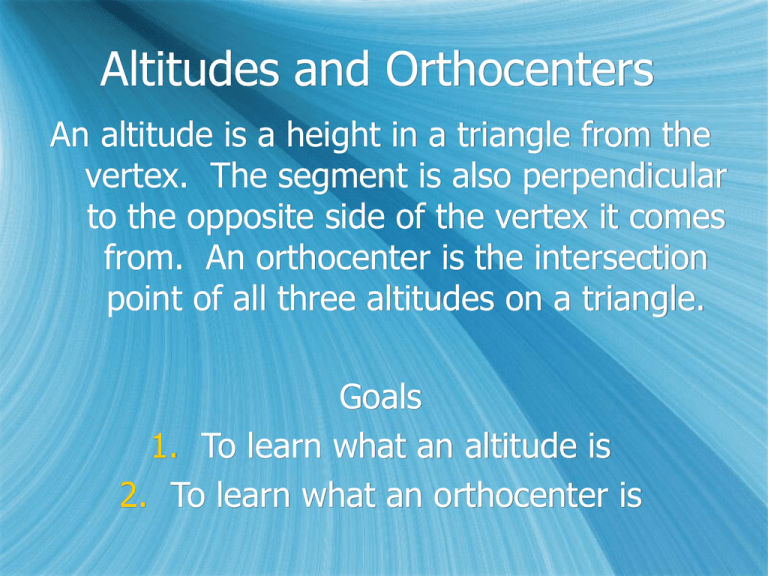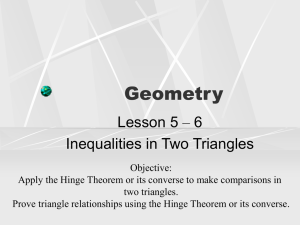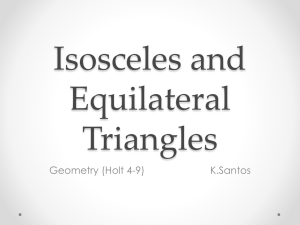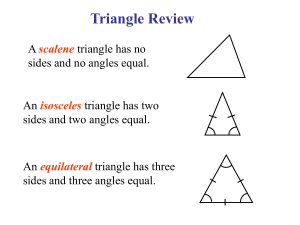Crook Problems
advertisement

Altitudes and Orthocenters An altitude is a height in a triangle from the vertex. The segment is also perpendicular to the opposite side of the vertex it comes from. An orthocenter is the intersection point of all three altitudes on a triangle. Goals 1. To learn what an altitude is 2. To learn what an orthocenter is Facts Altitudes can also be medians and angle bisectors when it is in an isosceles triangle. QuickTime™ and a decompress or are needed t o see this picture. Orthocenters can be outside, Inside, or on a vertex depending On the type of triangle QuickTime™ and a decompressor are needed to see this picture. Sample Problems Write sometimes, always, or never. 1. Altitudes cut angles in half. (Sometimes) 2. What is the angle measure a of a? (90 degrees) 3. Where does the orthocenter lie in an obtuse triangle? (Outside) Web Links http://www.cliffsnotes.com/study_guide/AltitudesMedians-and-Angle-Bisectors.topicArticleId18851,articleId-18787.html http://www.homeschoolmath.net/teaching/g/altitude. php http://www.pinkmonkey.com/studyguides/subjects/g eometry/chap2/g0202401.asp Isosceles Triangle Summary Meg Berlengi Period 4 An Isosceles Triangle is a triangle with two equal sides. The Isosceles Triangle have legs and a base. They also have a vertex angle and base angles. When solving an isosceles triangle problem, there are many theorems or postulates used; some are the Base Angle Theorem and the Triangle Sum Theorem. There are examples on slide 3 of isosceles triangle problems. QuickTime™ and a decompressor are needed to see this picture. QuickTime™ and a decompressor are needed to see this picture. Rules, Properties, and Formulas QuickTime™ and a decompressor are needed to see this picture. Isosceles Triangle Theorem- the angles opposite the two equal sides are equal. Base Angle Theorem- If two sides of a triangle are congruent, then the angles opposite them are congruent. Converse Base Angle Theorem- If two angles of a triangle are congruent, then the sides opposite them are congruent. Triangle Sum Theorem- the sum of the measures of the interior angles of a triangle is 180° The vertex angle is the angle opposite the base. The base angles are the two angles adjacent to the base. Examples Solve for x. 3. 2. 1. Solve for x. Solve for the missing angles. QuickTi me™ and a decompressor are needed to see thi s pi cture. Qui ckTime™ and a decompressor are needed to see this pi cture. Solution: If two angles of a triangle are congruent, the sides opposite them are congruent. Set: 6x - 8 = 4x + 2 2x = 10 x=5 Note: The side labeled 2x + 2 is a distracter and is not used in finding x Solution: If two sides of a triangle are congruent, the angles opposite them are congruent. So m<1 = m<2 and m<3 = 40 degrees. 180 - 50 = 130 180 - (40 + 40) = 100 m<1 = 65 degrees m <4 = 100 degrees m<2 = 65 degrees Solution: 68 68 136 180 136 44 4x 2 44 180 4x 42 180 4x 48 x 12 Web Links http://www.mathwarehouse.com/geometry/congruent_triangles/isoscelestriangle-theorems-proofs.php http://hotmath.com/hotmath_help/topics/converse-of-isosceles-triangletheorem.html http://www.regentsprep.org/regents/math/geometry/GP6/PracISOS.ht m Converse, Inverse, Contrapositive Kylie Helfenbein Period 4 Summary The converse, inverse, and contrapositive are based off the basic understanding of a conditional statement. A converse is formed when the hypothesis and conclusion of a conditional statement are exchanged. An inverse is formed by negating the hypothesis and conclusion of a conditional statement. A contrapositive is formed by negating the hypothesis and conclusion of a converse statement. Rules, Formulas, Properties To express all three statements, work off the basis of a conditional, where p-->q. The converse can be expressed by saying q ->p The inverse can be expressed by saying ~p -> ~q, where the “~” negates the statement. The contrapositive can be expressed by saying ~q --> ~p Truth Value The conditional and the contrapositive have the same truth value. The converse and the inverse have the same truth value. Sample problems 1. If you are in North America, then, you are in the United States. Form a converse, inverse, and contrapositive from these statements. Answer: Converse: If you are in the United States, then, you are in North America. Inverse: If you are not in North America, then you are not in the United States. Contrapositive: If you are not in the United States, then, you are not in North America. Sample Problem Using the same conditional, determine the truth value. “If you are in North America, then you are in the United States.” Answer: The conditional and contrapositive are false, you do not have to be in the U.S. to be in North America. The inverse and converse are true, because if you have to be in North America to be in the U.S. Sample Problem Which of the following represents a converse to the statement, k--> h? A. ~k --> ~h B. ~h --> ~k C. h --> k Answer: C. h --> k, to find a converse, you must exchange the wording of the original conditional statement. Weblinks How to form statements http://hotmath.com/hotmath_help/topics/converse-inversecontrapositive.html http://mathforum.org/library/drmath/view/55349.html definitions of terms http://library.thinkquest.org/2647/geometry/glossary.htm Triangle Exterior Angle Theorem/Exterior Angle Sum Theorem By: Aubrey Postolakis SUMMARY Triangle Exterior Angle Theorem- is when the measure of an exterior angle of a triangle is equal to the sum of the two angle measures of the two nonadjacent interior angles. Exterior Angle Sum Theorem- is when the sum of all three angle measures of the interior angles of the triangle equals 180 degrees. FORMULAS Triangle Exterior Angle Theorem- this is used to find the measure of the angle of the exterior angle and you find this by finding the sum of the two nonadjacent interior angles of the triangle m ∠4 = m ∠1 + m ∠2 Exterior Angle Sum Theorem- this theorem proves that when you add up all of the three interior angles of a triangle it will equal 180 degrees. m ∠1 + m ∠2 + m ∠3 = 180 Exterior Angle Sum Theorem EXAMPLES 1.) 1.) Example Problem Triangle Exterior Angle 2.) Example Theorem 3.) Example Problem Problem 2.) Solution 3.) HELPFUL LINKS Triangle Exterior Angle Theorem http://www.kwiznet.com/p/takeQuiz.php?ChapterID=10730&CurriculumID=42& Num=6.3 http://www.cliffsnotes.com/study_guide/Exterior-Angle-of-aTriangle.topicArticleId-18851,articleId-18784.html http://www.mathopenref.com/triangleextangle.html Exterior Angle Sum Theorem http://www.winpossible.com/lessons/Geometry_Triangle_AngleSum_Theorem.html http://www.brightstorm.com/math/geometry/triangles/triangle-angle-sum http://www.cliffsnotes.com/study_guide/Angle-Sum-of-a-Triangle.topicArticleId18851,articleId-18783.html Math Text Book- Chapter 4 http://www.classzone.com/eservices/index.cfm? Crook Problems By Lauren Snieckus What are crook problems? A crook problem is a type of set of parallel lines and transversals. In a crook problem, the transversal is an angle that forms a “crook”, rather than a straight line. They can be solved by drawing a horizontal line through the angle inside of the two parallel lines, forming another parallel line. Or, they can be solved by drawing a line perpendicular to the two parallel lines, intersecting the point of the angle inside of them. A third method used is continuing the segments forming the angles of the “crook” until they intersect with the two parallel lines. With this type of problem, there is now multiple transversals. Example 1 Find x if l||m. X=110 Example 2 Find x and y if s||t X=48 Y=108








